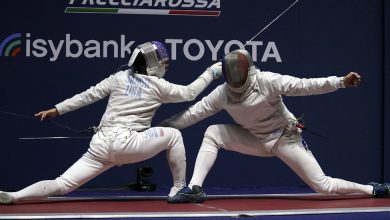Bobsleds Come Down Fast. This Is How They Go Back Up.

YANQING, China — One after another, the bobsleds blurred through the curves at the National Sliding Center, each covering nearly a mile of icy twists and turns in just under an adrenaline-inducing minute.
But what came down — in this case very rapidly — has to go back up.
That return to the top for Olympic bobsled teams plays out much slower. How it happens is the story a little bit of laughter, a lot of sweat and, of course, the utmost care. And then there’s the truck.
*
During Wednesday’s four-man training, teammates lifted their bobsled off the track after their first heat, laying it on its side.
“It’s a very blue-collar sport,” said Frank Del Duca, a 30-year-old pilot for the United States. “We come down. We pick up our sleds. They weigh over 400 pounds.”
They carefully placed it on a flat dolly, similar to ones used for moving large furniture.
Next, they wheeled it to one of a steady procession of waiting white trucks that resembled U-Haul vans. (The bobsled is first weighed on competition days to make sure it is within regulations). A driver backed the truck to the edge of the platform, allowing the athletes to load their bobsled.

Explore the Games
- Under Scrutiny: As Russian athletes score more wins, present and past doping scandals, as well as the situation in Ukraine, are casting a shadow over their triumphs.
- Caught in the Middle: American athletes of Chinese descent in Beijing have become targets of patriotic sentiment, both adoring and hostile, from both China and the U.S.
- An Ice-Suit Clad Panda: The search for souvenirs of the Olympic mascot, Bing Dwen Dwen, in Beijing involves long lines and eye-popping price tags.
- The Quest for Good Food: Hungry athletes, officials, volunteers and journalists have been trying, with effort and persistence, to find moments of delicious culinary diversion, however small.
“We go up these steep hills and sometimes they get icy and sometimes the trucks get stuck and they’re trying to get up,” said Jimmy Reed, a push athlete for the United States. “So, if they’re not tied to the front of the truck, sometimes sleds do fall out. It has happened. It hasn’t happened here.”
*
The trucks fit two four-man teams. Competitors from different nations piled in together.
“We help each other out,” Del Duca said. “There’s a certain level of danger. So, we have a certain level of respect and camaraderie for each other.”
Some stood, grabbing onto straps like on a subway. The pilots usually sat in their bobsled, their legs dangling outside the truck’s rear.
“There’s not a single nation I don’t think I couldn’t have a conversation with,” said Hunter Church, a 25-year-old pilot for the United States. “Russia. Germany. Latvia’s a little quiet sometimes, but I’ll try and crack a few jokes with them.”
The truck meandered up a back road, retracing the track’s many bends. Its raised back offered sweeping views of the snow-capped Xiaohaituo mountain area and the nearby Alpine ski center.
If they were not in conversation with their competitors, the bobsledders were dissecting their recent run.
“I have myself, I have my team and then I have my coach,” Church said. “That’s usually a big part of what we’re doing and then hyping each other up for the next one down.”
*
After a ride of about five minutes, the truck backed to the edge of the parc fermé, the secure staging where the bobsleds mobilize near the start gate.
The athletes slipped booties over their $300 spikes before stepping out of the truck.
“We’re just trying to protect the spikes as much as we can when we’re walking around on cement and wood, so they stay as fresh and sharpened as long as possible,” said Carlo Valdes of the United States.
*
Together, the athletes picked up the bobsled, placing it on another dolly. They escorted it to an area known as the ice box, a square sheet of ice, placing it on its side for a minute.
In the past, bobsledders used blow torches to heat their runners, the blades that make contact with the ice, reducing friction to make their sleds faster.
Now, the temperatures of all the runners have to be within four degrees of a reference runner that is exposed outside for at least an hour in order to meet the regulations of the International Bobsleigh and Skeleton Federation. The ice box ensured the temperatures were within the range.
“This makes it more equal and easier for everybody,” said Normunds Kotans, a Latvian sliding sports expert with the Beijing Organizing Committee. “No one needs to think about it.”
Next, a national technical official cleaned and wiped the runners to make sure no water had attached to them.
*
The athletes can tinker and adjust the runners on training days. During competition heats, they are not allowed to make any adjustments beginning 45 minutes before the start of the event.
The bobsleds entered the assembly line for their final ride of the day like planes readying to taxi. Some of the bobsledders stretched and warmed up, trying to keep warm in the 11-degree Fahrenheit weather.
“There’s so many little things that you wouldn’t expect that need to be done to make a huge facility and production like this for us to go and make a minute trip,” said Josh Williamson, a push athlete for the United States.



